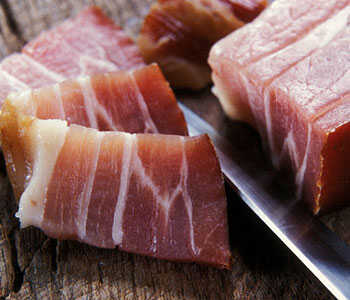
O que é o sal de cura?
Sal de cura é um aditivo utilizado na produção de alimentos curados. Sua principal função é a preservação ao inibir a contaminação por bactérias e fungos. Um dos grandes motivos para sua utilização é a supressão da proliferação da bactéria clostridium botulinum, que contamina o alimento com a toxina botulínica. Além da preservação o sal de cura ainda age como antioxidante e agregador de sabor e coloração específicos de alimentos que fazem uso deste aditivo. Geralmente é utilizado em salsichas, linguiças ou carnes curadas(defumadas e/ou secas). O sal de cura é compostos por uma mistura de sal de cozinha, nitrito de sódio e/ou nitrato de sódio. O sal de cura age na carne conferindo a coloração avermelhada típica de produtos curados, como o salame, mortadela, linguiças e salsichas.
A coloração vermelha característica dos produtos cárneos curados cozidos (quer dizer, os que contêm nitrito ou nitrato) se deve ao pigmento nitrosilhemocromo, que é a forma desnaturada, por calor, da nitrosomioglobina, a qual, por sua vez, é formada por meio da reação entre óxido nítrico (NO) proveniente do nitrito (NO2) e mioglobina natural da carne. Durante o cozimento, a cadeia de proteínas da mioglobina (globina) se desnatura e se separa do grupo heme, produzindo, assim, o já mencionado nitrosilhemocromo, responsável pela coloração característica avermelhada dos produtos cárneos curados e cozidos.
A intensidade dessas reações depende de algumas condições, tais como a presença e a ação de determinados micro-organismos, agentes redutores naturais na carne (antioxidantes naturais/vitaminas), enzimas mitocondriais, antioxidantes adicionados, pH do meio, potencial de oxirredução, tipo e forma de embalagem, pressão de oxigênio e tempo e temperatura de conservação/armazenamento. São muitos os detalhes tecnicos, mas no geral há sim uma regra e proporção que pode ser utilizada com segurança. Não é preciso entender todos os detalhes, apenas o básico que detalhamos abaixo.
Os sais de cura que seguem a padronização norte americana(instacure#1 e instacure#2) são compostos por 93.75% de sal de cozinha(cloreto de sódio) e 6.25% de nitrito de sódio(NaNO²). Alguns contém 4% de nitrato de sódio. O nitrato de sódio(NaNO³) gradualmente perde uma molécula de oxigênio durante o processo de cura e passa a ter a mesma composição do nitrito de sódio, por essa característica é utilizado em processos de cura mais longos, tendo ação mais lenta e prolongada.
Para saber mais sobre o nitrito de sódio e o nitrato de sódio, leia Nitrito e Nitrato de sódio.
Quanto sal de cura utilizar?
Cada receita costuma pedir uma quantidade diferente e isso tende a criar confusão na decisão de quanto sal de cura utilizar. Por esse motivo o ideal é padronizar pelas limitações estabelecidas pelos órgãos competentes.
Os cálculos abaixo apresentados foram feitos com base no sal de cura que segue o padrão norte americano para a designação de Sal de cura 1 ou, como também é conhecido, Instacure#1, que contém 6,25% de nitrito de sódio e 93,75% de sal comum(Cloreto de Sódio). No Brasil não há padronização, portanto é importante conferir a quantidade no produto adquirido.
A Diretoria Colegiada da Agência Nacional de Vigilância Sanitária, através da RDC nº 272, de 14 de março de 2019, dispõe sobre os aditivos alimentares autorizados para uso em carnes e produtos cárneos, nela determina que o nível de nitrito e nitrato residual no produto final não pode ultrapassar 0,015g por 100g de produto, ou 150ppm. Desta forma é preciso que o nitrito adicionado seja reduzido durante o processo de cura, garantindo que este limite não seja atingido no produto pronto para consumo. Seguindo a legislação é limitado um máximo de 0,015g de nitrito de sódio residual para cada 100g ou ml de produto(carne) ou solução(salmoura). Confira aqui a tabela oficial de aditivos e quantidades de referência.
O sal de cura que segue o padrão norte americano instacure#1 contém 6,25% de nitrito de sódio, ou seja, 1g de sal de cura contém 0,0625g de nitrito de sódio. Pelos nossos cálculos o limite residual estabelecido é de 2,4g de sal de cura para cada 1kg de carne\salmoura. Ou seja, esse é o mínimo a ser acrescentado, pois usando esta medida o produto final nunca terá mais do que o máximo residual estabelecido pois já está no limite e ainda há uma forte redução durante o processo de cura. Leia o post Tempo de conversão do nitrito nas carnes curadas onde são apresentados estudos sobre a redução/conversão do nitrito nos produtos.
A união européia limita, assim como no Brasil, em 150ppm máximos, mas há excessões como a Dinamarca, que limita em 60ppm.
A norte americana FSIS(Food Safety and Inspection Service) diferencia os tipos de processos de inserção do nitrito, como injeção, massageamento e imersão. Na técnica de imersão e massageamento estabelece o limite de 200ppm de nitrito de sódio para a carne crua do produto a ser curado. É o equivalente a 0,02% de nitrito de sódio. Convertendo chegamos a 0,2g de nitrito de sódio para cada quilo de carne. Calculando chegamos a 3,2g de sal de cura para cada kg de carne. Limite um pouco maior do que o estabelecido no Brasil. A legislação norte americana ainda prevê um mínimo a ser adicionado que é de 120ppm. Ou seja, por medida de segurança nenhum produto carneo curado por ter adição inferior a esse limite.
Está bem fundamentado cientificamente que são necessários pelo menos 50-75 ppm de nitrito para manter uma coloração de cura adequada na carne e conseguir inibir a oxidação dos lipídios, bem como são necessárias de 75 a 100 ppm de nitrito para contribuir com o controle de micro-organismos patógenos e de decomposição.
Reiteramos que os valores calculados referem-se ao sal de cura que segue o padrão norte americano, denominado instacure#1, ou, como é comumente chamado no Brasil, sal de cura 1.
Seu sal de cura contém quantidades diferentes de Nitrito de Sódio do que a usada no cálculo? Use a nossa Calculadora de aditivos alimentares
Se quiser conferir e fazer sua análise e cálculos(recomendável), veja o documento da FSIS
Qual é a diferença entre o sal de cura 1 e o sal de cura 2?
Para entender a diferença entre esses tipos de sal de cura, leia o post Sal de cura 1 e Sal de cura 2.
O uso do sal de cura é obrigatório?
A maioria dos produtos cárneos processados, como salame, salsicha, linguiça, copa, bacon, presunto e mortadela destinados à comercialização devem obrigatoriamente conter o nitrito de sódio, que geralmente é acrescido na forma de sal de cura. Os estados e municípios, através de secretarias específicas seguem as diretrizes nacionais e certificam estabelecimentos e produtos para comercialização dentro de seus limites territoriais.
Para a produção caseira destinada ao consumo pessoal o uso é opcional. Cada um deve avaliar os riscos e benefícios e decidir pelo uso, ou não, do sal de cura.
Botulismo
Esse é um dos maiores dilemas quando pensamos em não utilizar o sal de cura. Há certa controvérsia sobre os malefícios à saúde pelo consumo exagerado do nitrito de sódio, mas a toxina botulínica é real e perigosa. Proveniente de “botulus”, salsicha em latim, o botulismo não é causado pela bactéria clostridium botulinum em si, mas pela toxina gerada pela bactéria, portanto não adianta eliminar a bactéria, é preciso garantir que não tenha havido contaminação. Essa bactéria não se desenvolve em pH < 4,5 (ácido), ou seja, um importante fator é garantir acidez nos produtos. Ao preparar carne curada, como o salame por exemplo, é recomendável acompanhar a acidez do produto durante todo o processo para garantir que esteja com o pH correto. Uma combinação de fatores(barreiras de proteção) é o ideal para garantir a segurança de um produto. Veja as principais barreiras de proteção na tabela abaixo.
Apesar de ser possível evitar o botulismo sem a ação do sal de cura, o nitrito ainda é usado pela combinação de fatores e principalmente pelos demais benefícios auferidos, como coloração e sabor.
Dúvidas? Deixe uma pergunta nos comentários!
-
 Sal de cura 1R$ 8,00
Sal de cura 1R$ 8,00 -
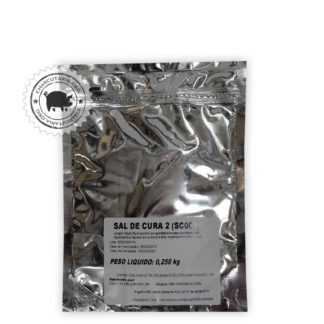 Sal de cura 2R$ 8,00
Sal de cura 2R$ 8,00 -
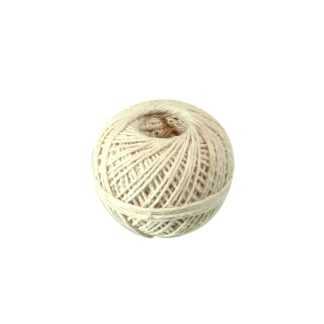 Barbante culinárioR$ 7,90
Barbante culinárioR$ 7,90 -
 Tripa suína natural para linguiçaR$ 52,00
Tripa suína natural para linguiçaR$ 52,00 -
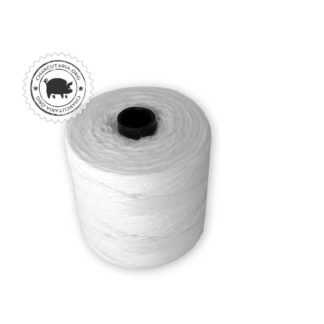 Barbante culinário poliésterR$ 16,00
Barbante culinário poliésterR$ 16,00 -
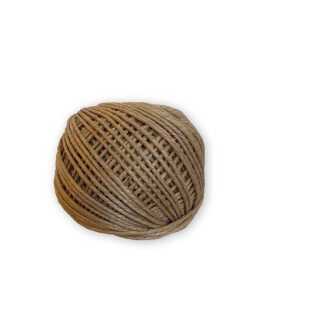 Barbante encerado ramiR$ 14,00
Barbante encerado ramiR$ 14,00 -
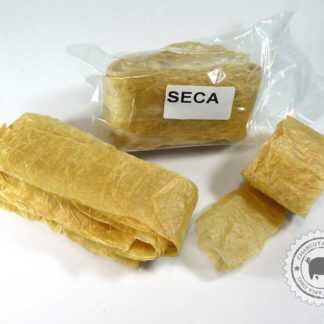 Tripa Bovina SecaO preço original era: R$ 19,00.R$ 15,00O preço atual é: R$ 15,00.
Tripa Bovina SecaO preço original era: R$ 19,00.R$ 15,00O preço atual é: R$ 15,00. -
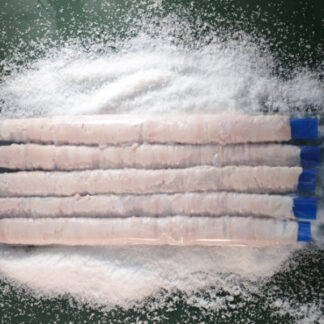 Tripa suína tubingR$ 39,00
Tripa suína tubingR$ 39,00


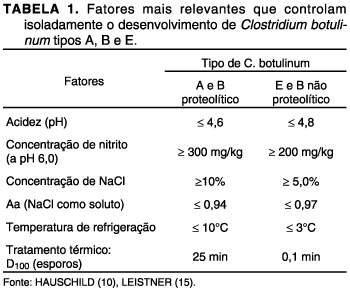
oi eu queria saber , quantidade de sal de cura x kg de carne crua, .
pode marinar varios dias?, que tipo 1 o 2 ?
O que acontece se colocar sal de cura em excesso na linguiça frescal ?
Oi! Para defumar peito de frango, deve ser feito cura com qual sal? 48hrs de cura já está bom?
Olá, gostaria de uma receita de salame artesanal defumado, vcs teriam?
Salame Ciauscolo
Olá! tudo bem? fiz uma cura de sal em carne de porco; usei apenas sal. O sabor está bem agradavel. Não sei se vc sabe dizer, mas existe risco em consumir esse produto?
Eu evitei usar o sal de cura, pelos males que ele pode causar tb. Se nas próximas eu quiser usar o sal para a cura (para se fazer um presunto cru, por exemplo) uso o numero 1 ou 2? Outra coisa, qual a qtde minima para se usar por quilo de carne?
Agradeço muito sua atenção!
Celio
Oi Celio. Para presunto cru deve usar o sal de cura 2. O sal de cura tipo 1 é para produtos que ficam prontos e são consumidos rapidamente, como linguiças para churrasco. Pode consumir só com o sal, o sal de cura é uma proteção adicional. Vale a pena usar o mínimo recomendado, que é de 2,4g por kg de carne.
Obrigado, Eduardo!!
Posso usar sal de cura para temperar carne de porco para fazer churrasco
Pode usar o sal de cura tipo 1 para carnes de churrasco. Recomendo que tempere antes, aguarde, pelo menos, 24 horas antes de assar e use um antioxidante em combinação para acelerar a conversão do nitrito.
Mano, o sal de cura é um conservante, mas não vai “salgar” a carne igual ao sal de cozinha. Toma cuidado com as proporções.
Se é pra churrasco o consumo deve ser imediato, aí vc pode usar o sal de cozinha NaCl saca
Bom dia! Para 100kg qual seria a quantidade de sal de cura ? 300g?
250g de sal de cura no padrão instacure.
Devo misturar o sal de cura com sal de cozinha para usar ou uso o sal de cura e depois uso o sal de cozinha?
Como fazer charque que vende nas vendas .
Devo usar 2,4g de sal de cura por kg de carne e complemento com o sal de cozinha?
Boa tarde
Posso usar sal de cura tipo 2 para fazer lombo defumado? Existe algum problema?
Grato.
Boa noite,
Qual sal de cura devo usar para fazer linguiça frescal? E tbm se no caso das linguiças frescais, basta utilizar o sal de cura apenas com nitrito? E por fim, qual a quantidade a ser utilizada e se levo em consideração o peso da carne+gordura para calcular o sal de cura.
Bom dia.
Posso utilizar sal de cura numa salmoura para carne de porco? E se positivo como utiliza-lo em quantidade? Existe medidas específicas quanto a quantidade de litros de salmoura por quilo de carne? É possível adicionar ervas e especiarias? E o tempo preciso deixar a carne nessa salmoura com sal de cura?
Desde já agradeço
Boa noite eu fiz bacon caseiro coloquei sal de cura muito mais do permitido faz mal a saúde
Bom dia chamo me Emília Mendes sou de Angola estou muito interessada em aprender charcutaria via a minha avó a fazer quando era pequena. Sinto que é o negócio certo para mim.
Quero saber se vocês dão cursos online
Oi Emilia, no momento não temos cursos.
devo usar so sal de cura ou uso sal comum tambem p linguica
Por favor, uma duvida, acompanhei uma receita italiana para preparar um copa lombo, eles utilizam apenas sal marinho la 24 gramas para aproximadamente peça de 1 kg, mas vejo que aqui se recomenda a utilização de sal de cura 2, sendo assim, é isto mesmo, devo utilizar sal de cura e o restante podendo ser o sal marinho?
Boa noite
Qto sal de cura tipo 2 devo usar por kg para fazer presunto cru?
2,4g por kg do pernil. Usar o sal de cura tipo 2, que contenha sal comum de cozinha, nitrito e nitrato de sódio. Como este: Sal de cura 2
Como o presunto é salgado duas ou três vezes no início do processo a cada 10 dias , recomenda usar o sal de cura 2 na primeira salgatura ou segunda, ou tanto faz?
Logo na primeira vez para já adquirir a proteção. Há diversos processos diferentes para fazer o presunto cru, muitos salgam apenas uma vez.
olá, na salmoura a quantidade de sal de cura se calcula pelo peso da carne, carne + agua, agua.
Obrigado.
Pela quantidade de água + carne.
Se usa sal de cura em Linguiças de peixe ou frutos do mar?
Boa tarde comprei sal de cura mas contem 4% de nitrato qual o cauculo fazer?obs vou fazer panceta a rotolatta
Só nitrato, não tem o nitrito?
Olá, quais aditivos posso usar para deixar a carne seca rosada e qual a proporção por kilo de carne.
Boa tarde! Preparei a minha salmora para o pastrami e adicionei 7 g de cura 1 numa peça de 1,1 kg. A recomendação do fabricante da cura 1 era 5 g para 1 kg. Também segui a recomendação da sua receita de pastrami que adiciona 7,5 g. Enfim, é uma quantidade segura?
Olá, qual sal de cura posso usar no hambúrguer.
sal de cura tipo 1 https://charcutaria.org/produto/sal-de-cura-1-cura-rapida-linguicas-e-salsichas-b001/
Fui comprar sal 1 para fazer um bacon a vendedora disse que era sal 2 e minha filha comprou o sal 2 ,posso botar o sal 2 numa cura rápida que é para sal 1
Sim, pode colocar o sal 2. O nitrato do sal de cura 2 não fará efeito pelo curto tempo, mas não há problemas.
Poxa, que bom que achei essa conversa! Faz dias que pesquiso essa questão de usar o sal 2. Obrigada!! Divulgue essa informação!!
Errei nas medias e coloquei 30 gramas por kilo ao inves de 3 gramas de sal de cura. Devo descartar tudo por conta do excesso de nitrito ou e possivel retirar na lavagem?
Oi Rafael. Em 30g de sal de cura há cerca de 1,8g de nitrito, o que é realmente muito. Recomendo que descarte.
BOA TARDE GOSTARIA DE SABER O SEGUINTE GUANDO ESAMOS SAL DE CURA ESTE SUBSTITUE O SAL COMUM? EM VEZ DE 3% DE SAL COMUM USAMMOS 3%DE SAL DE CURA?
ATT. Denis Perin
Oi Denis. Não, o sal de cura é para ser usado na quantidade de 0,25%, ou seja, 2,5g por kg de carne. O restante deve usar de sal comum.
Olá bom dia tenho uma dúvida quero fazer linguiça de camarao e peixe quanto de sal de cura devo usar? Mesma porcentagem que uso para as carnes bovina e suina?
Oi Yuri, mesma porcentagem.
Boa tarde posso usar o sal de cura 2 para fazer charque?
Oi Walter. O charque não leva sal de cura. Pesquise por “Regulamentos Técnicos de Identidade e Qualidade (RTIQ) do charque”
Bom dia, adquiri um sal de cura 1 aqui na minha cidade para fazer Linguiça Fresca. Na embalagem diz apenas que contém 93% de Sal e 7% de Nitrito.
Em um site que também comercializa o produto diz que o recomendado é utilizar 1kg de Cura para 100kg de carnes, ou seja, 10g de cura para cada quilo.
Estou achando muito, será que por segurança eu poderia usar como padrão 2,5g por Kg uma vez que seguindo os cálculos 7% de Nitrito daria 2,14g por kg ?
Oi Alex. Pela composição do sal de cura 1 que comprou pode usar como padrão em suas receitas os 2,5g por kg de carne.
Valeu Eduardo